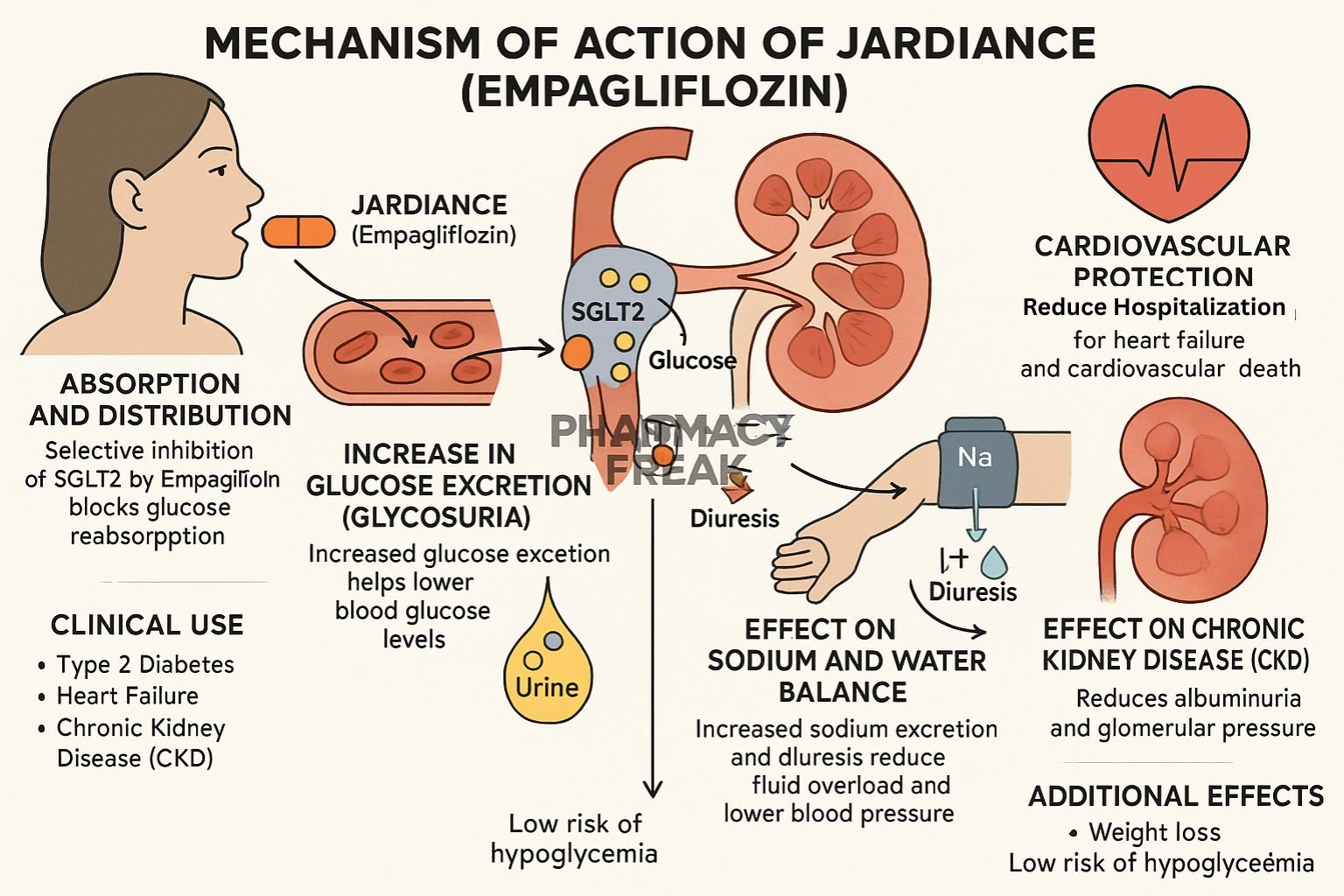Table of Contents
Introduction
Jardiance (empagliflozin) is a sodium–glucose co-transporter 2 (SGLT2) inhibitor used for type 2 diabetes mellitus (T2DM), heart failure with reduced ejection fraction (HFrEF), and chronic kidney disease (CKD). It lowers blood glucose by increasing renal glucose loss and offers cardiovascular and renal benefits.
Step-by-Step Mechanism of Action
- Selective inhibition of SGLT2 in proximal tubules
Empagliflozin blocks the SGLT2 transporter in the early proximal convoluted tubule of the kidney, preventing reabsorption of filtered glucose and sodium. - Increased urinary glucose excretion
Blocking SGLT2 results in excretion of about 60–80 g of glucose daily, lowering plasma glucose and reducing HbA₁c. - Osmotic diuresis and natriuresis
Glucosuria induces an osmotic diuretic effect, promoting sodium loss, reducing blood volume and preload, and lowering blood pressure. - Weight reduction and metabolic improvements
Loss of calories via glucosuria contributes to weight loss and improves glycemic control and insulin sensitivity. - Cardiorenal protective effects
Empagliflozin reduces intraglomerular hypertension, decreases albuminuria, and lowers heart failure hospitalizations—likely via hemodynamic and metabolic mechanisms.
Pharmacokinetic Parameters
| Parameter | Value |
|---|---|
| Route | Oral (tablet), once daily |
| Bioavailability | ~78% |
| Time to Peak (Tmax) | ~1.5 hours |
| Protein Binding | ~86% |
| Metabolism | Minimal via glucuronidation (UGT2B7, UGT1A3/1A8/2B4) |
| Half-life | ~12 hours |
| Excretion | ~54% urine (unchanged), ~41% feces |
Clinical Uses
- Glycemic control in type 2 diabetes
- Reduction in HFrEF-related cardiovascular death and hospitalization, with or without diabetes
- Delay progression of chronic kidney disease
Adverse Effects
- Genitourinary infections: yeast infections and UTIs
- Volume depletion: hypotension, dizziness
- Rare cases of euglycemic diabetic ketoacidosis
- Slight increases in LDL cholesterol and magnesium
Comparative Analysis
| Agent | Selectivity | HbA₁c Reduction | Weight Loss | Cardiorenal Benefit |
|---|---|---|---|---|
| Empagliflozin (Jardiance) | High SGLT2 selectivity | 0.5–1.0% | 2–3 kg | Yes |
| Canagliflozin | SGLT2 ≈ SGLT1 | 0.8–1.1% | 2.5–3.5 kg | Yes |
| Dapagliflozin | SGLT2 > SGLT1 | 0.5–1.0% | 2–3 kg | Yes |
MCQs
- Empagliflozin inhibits which transporter?
a) SGLT1 b) SGLT2 c) GLUT2 d) Na⁺/K⁺ ATPase
Answer: b) SGLT2 - Daily urinary glucose loss is approximately:
a) 20 g b) 40 g c) 60–80 g d) 100 g
Answer: c) 60–80 g - The diuretic effect arises from:
a) Loop diuretic action b) Osmotic diuresis c) Thiazide-like effect d) Aldosterone antagonism
Answer: b) Osmotic diuresis - Weight loss with empagliflozin is due to:
a) Appetite suppression b) Caloric loss via glucosuria c) Metabolic rate increase d) Lipid absorption blockade
Answer: b) Caloric loss via glucosuria - Cardiorenal benefits include:
a) Increased albuminuria b) Reduced hospitalizations c) Higher blood pressure d) Reduced LDL only
Answer: b) Reduced hospitalizations - Metabolism primarily occurs via:
a) CYP3A4 b) Glucuronidation c) CYP2D6 d) Renal excretion unchanged
Answer: b) Glucuronidation - Excretion route includes:
a) Mainly renal b) Mainly biliary c) Equally renal & fecal d) Pulmonary
Answer: c) Equally renal & fecal - A rare but serious side effect is:
a) Hyperglycemia b) Euglycemic ketoacidosis c) Hypothyroidism d) Liver injury
Answer: b) Euglycemic ketoacidosis - Protein binding is about:
a) 50% b) 70% c) 86% d) 99%
Answer: c) 86% - Time to peak plasma concentration is:
a) 30 min b) 1.5 hrs c) 5 hrs d) 12 hrs
Answer: b) 1.5 hrs
FAQs
1. Can empagliflozin be used without diabetes for heart failure?
Yes—it’s approved for HFrEF regardless of diabetic status.
2. Should renal function be monitored?
Yes—check baseline and periodically, especially in CKD patients.
3. Is empagliflozin associated with hypoglycemia?
Not when used alone; risk increases with insulin or sulfonylureas.
4. How soon are cardiorenal benefits seen?
Clinical benefits often begin within a few months.
5. How long should treatment continue?
Long-term use is common; discontinuation may be considered if no benefit or side effects occur.
References
- Goodman & Gilman’s The Pharmacological Basis of Therapeutics, 13ᵗʰ Edition
- KD Tripathi. Essentials of Medical Pharmacology, 8ᵗʰ Edition
- DrugBank: Empagliflozin pharmacology summary
- StatPearls: Empagliflozin mechanisms and clinical effects
- PubMed review: Cardiorenal safety of empagliflozin
I am pursuing MBA in pharmaceutical management from NIPER Hyderabad with a strong academic record and proven success in national-level pharmacy entrance exams. I secured AIR 61 in NIPER 2024 (MS/M.Pharm) and AIR 27 in NIPER MBA, along with AIR 147 in GPAT 2024 and AIR 907 in GPAT 2023. I also achieved AIR 6 in AIIMS CRE-2025 for Drug Store Keeper and was selected as a Pharmacist (AIR 61) for ESIC. Additionally, I was the Runner-Up in Round 2 of the EY Case Study Competition.
At PharmacyFreak.com, I aim to guide future pharmacists through expert content, exam strategies, and insightful resources based on real experience and academic excellence.
Mail- harsh@pharmacyfreak.com
